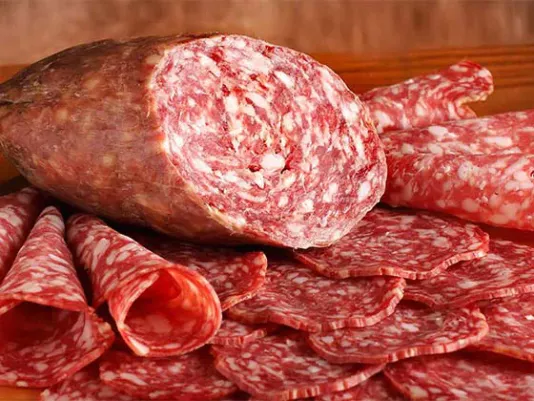Halloween Appetizer Plate
Halloween Appetizer Plate - There are no special dishes or recipes for celebrating Halloween.

Dry-cured sausage is a meat delicacy distinguished by its special preparation method and unique taste. It is made from selected meat, spices, and natural ingredients, then goes through smoking and a long maturing process. As a result, the sausage gains a dense texture, rich aroma, and complex flavor, making it a true highlight of any table. Over the years of my culinary practice, I have repeatedly found that this product is versatile: it works equally well for quick sandwiches and for complex dishes – from pasta and pizza to salads and Mediterranean-style appetizers. Dry-cured sausage has a pronounced character, yet it harmoniously combines with other ingredients, creating a balanced taste. For me, it is not only a delicious product but also an example of how traditional methods of processing can preserve and enhance the value of meat.
Dry-cured sausage has a centuries-old history, as smoking has long been one of the most effective ways of preserving meat. I always sense in this product a combination of traditions and modern culinary solutions. For preparation, selected meat is used, usually pork or a mix of pork and beef, blended with spices, salt, and sometimes wine. The sausage is then smoked with cold smoke and left to mature for several weeks or even months. This process gives it its characteristic rich taste and aroma, as well as a firm texture that makes it easy to slice thinly for serving. Different countries have their own traditions of making it: in Italy, it may be salami; in Spain – chorizo; in France – dry sausages with added herbs and spices. Each variety has unique nuances, but they all share the main principle – using high-quality meat and natural smoking, creating an unmistakable gastronomic identity. For me, dry-cured sausage is a symbol of authenticity and true craftsmanship preserved in modern cuisine.
Dry-cured sausage stands out with its deep, multi-layered taste that combines salty, spicy, and subtle smoky notes. When I use it in dishes, I notice how even a small amount can add richness to the entire meal. The texture of the sausage is firm, yet tender when sliced, making it ideal for appetizers and cold dishes. When paired with vegetables or cheeses, it creates a balanced contrast, while in hot dishes – pasta, pizza, or casseroles – it reveals its aromatic properties even more. I also like adding thin slices of sausage to salads: they bring piquancy and make the dish more filling. It is also important that dry-cured sausage stores well without losing its flavor qualities, making it convenient for daily use. In world cuisine, this product is considered a delicacy, as it can serve both as the main accent of a dish and as a subtle addition that enhances other ingredients. For me, the culinary value of dry-cured sausage lies in its versatility and ability to integrate harmoniously into any cuisine worldwide.
My experience shows that dry-cured sausage has a unique ability to pair with a wide variety of foods, creating harmonious yet expressive flavor combinations. It perfectly complements different types of cheese – from delicate mozzarella to aged Parmesan. In salads, the sausage pairs well with vegetables, especially tomatoes, arugula, or sweet peppers, creating a balance of freshness and richness. In hot dishes, I like to use it with mushrooms or olives – the flavor becomes deeper and more complex. In Mediterranean cuisine, sausage is often served with wine, grapes, or freshly baked bread, and I consider this one of the best combinations. Interestingly, sausage also goes well with sweet ingredients: for example, it can be served with figs or melon, creating a particularly refined contrast. Such combinations not only diversify the diet but also open new culinary horizons. I am convinced that the ability to pair dry-cured sausage with other foods is the key to creating dishes that leave a lasting impression.
Dry-cured sausage is widely used in many world cuisines, and I often experiment with it, combining it in my own dishes. In Italian cuisine, it is added to pasta, pizza, and various antipasti, giving dishes a rich taste and a pleasant smoky aroma. In Spanish cuisine, sausage can be served as a standalone appetizer or as part of tapas, paired with cheeses and olives. In American recipes, I use it for sandwiches and salads, where it adds spiciness and textural contrast. In French cuisine, dry-cured sausage is often included on platters of meat delicacies, where not only taste but also presentation matters. For me, it is fascinating to see how the same ingredient adapts to different culinary traditions while retaining its character and versatility. This makes it possible to create dishes that are both familiar and new, capable of impressing guests at any table.
My experience working with dry-cured sausage has shown that the right choice of product determines the taste and quality of the dish. Before buying, I always pay attention to the color, aroma, and firmness of the sausage: a quality product has a uniform color, a pleasant smoky smell, and an elastic texture, without signs of excess moisture or mold. It is best to store sausage in a cool, dry place or in the refrigerator in a tightly wrapped package to preserve its aroma and prevent drying out. Sliced sausage should be consumed within a few days, while whole pieces can last longer, depending on the smoking method and packaging. I also recommend slicing sausage into thin pieces just before serving to fully enjoy its aroma and flavor. For culinary experiments, sausage can be used in combination with vegetables, cheeses, sauces, and hot dishes, as it quickly integrates, enhancing the flavor of the main product. Following these simple rules allows you to fully enjoy dry-cured sausage, getting the most out of its taste in any recipe.